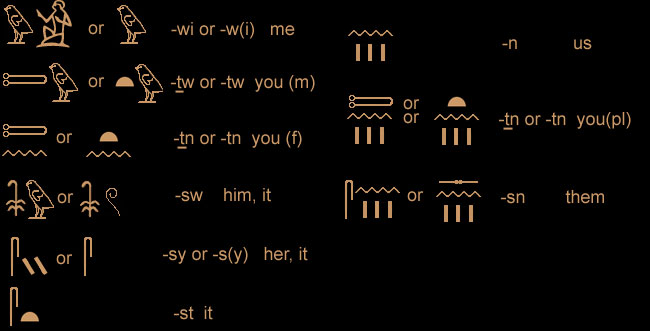A pronoun can be defined as a substitute for a noun. There are three types of pronoun in ancient Egyptian; suffix pronouns, dependent pronouns, and independent pronouns.
Suffix Pronouns
The Suffix Pronoun is always attached to a preceding word and is connected to it in transliteration by the symbol “=”. It will always be placed immediately after the word it is attached to (see below on word order). The suffix pronouns are as follows:

The first person suffix pronoun (“I”) is usually masculine (i.e. it is the glyph of a kneeling man) but this glyph can be replaced with that of a woman, a god, or a dignitary if the situation warrants this.
There are six main uses for suffix pronouns:
1: As the subject of a verb (but not an infinitive)

2: As the object after a preposition

3: As an indirect object of a verb

4: As the possessor or genitive of a noun

5: As the subject of a non-verbal statement beginning with the particle “iw”

6: As the subject following the word “djs” (“self”)

Dependent Pronouns
Dependent pronouns are not as closely connected to the word so they are written with “-“. The dependent pronoun will always precede the subject if it is a noun, but if the subject is a suffix pronoun the dependent pronoun will follow it.

There are three main uses for dependent pronouns:
1: As the object of a verb (but not an infinitive)

2: As the subject of a non-verbal statement beginning with a particle

3: As an object reflexively relating back to the subject of the verb

Hieroglyphs Resources
- Gardiner’s sign list
- Single consonant signs
- Phonograms, Logograms and Determinatives
- Nouns and Prepositions
- Relative Forms
- Pronouns
- Word Order
- Verbs forms
- Past and Present tense
Copyright J Hill 2010